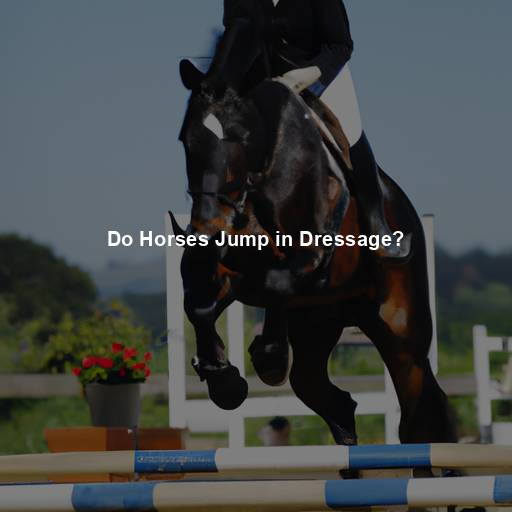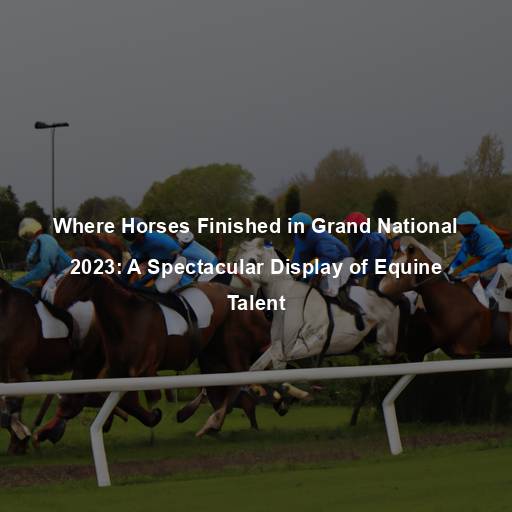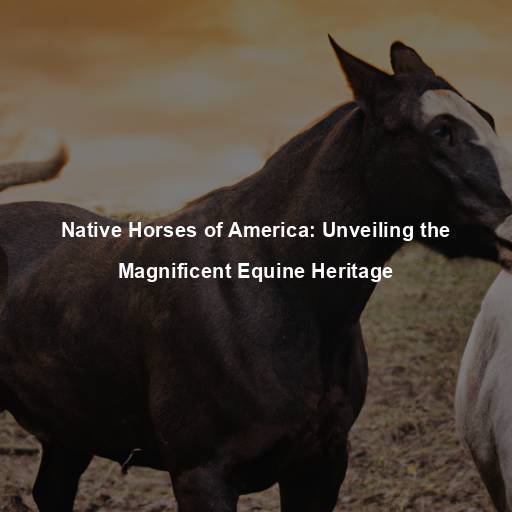Do Horses Jump in Dressage?
Last Updated on November 2, 2023 by Evan
Contents
- 1 Understanding the Art of Dressage
- 1.1 The Essence of Dressage
- 1.2 The Role of Jumping in Dressage
- 1.3 The Evolution of Dressage
- 1.4 Preserving the Integrity of Dressage
- 1.5 Promoting Versatility and Adaptability
- 1.6 Balancing Tradition and Progression
- 1.7 The Future of Dressage
- 1.8 Enhancing Physical Ability and Athleticism
- 1.9 Building Confidence and Trust
- 1.10 Improving Adjustability and Responsiveness
- 1.11 Adding Variety and Mental Stimulation
- 1.12 Expanding the Rider’s Skill Set
- 2 FAQs: Do Horses Jump in Dressage?
Understanding the Art of Dressage
The world of dressage, known as the graceful “horse ballet,” has captivated equestrians for ages with its mesmerizing display of harmony between rider and horse. With its emphasis on precision and finesse, dressage demands a deep comprehension of equine movement. While dressage primarily centers around intricate flatwork like pirouettes and flying changes, traditional tests rarely encompass jumping. Yet, it is worth exploring the occasional incorporation of jumps in dressage training and competitions, even if their role remains somewhat limited.
The Essence of Dressage
Dressage, originating from the French word “dresser” meaning “to train,” is deeply rooted in the training and development of horses. It aims to enhance their athleticism, flexibility, and responsiveness through systematic training and exercises. The goal is to create a horse that can perform fluid, controlled, and expressive movements with minimal aids from the rider.
The training process involves progressive steps that gradually develop the horse’s physical strength, balance, and coordination. From basic movements like circles and transitions to advanced maneuvers such as piaffe and passage, dressage aims to create a harmonious partnership between horse and rider.
The Role of Jumping in Dressage
In the captivating world of dressage, the art of precision takes center stage, where riders and their majestic steeds harmonize in a ballet of equestrian elegance. Yet, amidst this timeless embrace, a fascinating enigma awaits—jumping, an unexpected twist! While not a customary element in dressage, this captivating discipline sometimes intertwines with the rhythmic dance, enriching the equine journey and unlocking new dimensions of skill and flair. As riders delicately navigate this captivating convergence, their horses embody a mystifying duality, seamlessly transitioning from the fluidity of flatwork to the soaring sensations of flight.
Gymnastic Exercises
Jumping exercises can be beneficial for dressage horses as they help improve their athleticism, suppleness, and adjustability. Gymnastic grids and cavaletti work can enhance the horse’s ability to collect, extend, and engage their hindquarters. These exercises also promote the development of balance, coordination, and agility, which are essential for executing advanced dressage movements with ease.
Cross-Training and Variety
Including jumps in a dressage horse’s training regime adds variety and mental stimulation, preventing them from becoming bored or stale. By engaging in different exercises and challenges, horses remain enthusiastic about their work and are more likely to maintain a positive attitude towards their training sessions. Additionally, cross-training between dressage and jumping can help develop a well-rounded athlete, as it encourages the horse to use their body in different ways and adapt to varying demands.
Test of Obedience and Focus
Dazzling readers with a stunning display of equine finesse, dressage tests have stealthily embraced an unexpected twist – jumps! These seemingly petite and unassuming obstacles pack a surprising punch, putting a horse’s obedience, focus, and submission to the rider’s aids on center stage. Striking a balance between grace and grit, the jumps demand unwavering rhythm, impeccable balance, and unwavering composure from our four-legged friends. It’s an exhilarating test of the horse’s attentiveness, as they must react swiftly and sensitively to their rider’s cues, unyielding even in the face of perplexing elements or unexpected distractions.
The Evolution of Dressage
Over time, dressage has undergone an enchanting transformation, incorporating an unexpected twist that has injected a whole new level of exhilaration into the sport. Enter “Dressage Eventing,” a hybrid format that intertwines the grace and precision of traditional dressage with the heart-pounding rush of cross-country jumping. This captivating discipline allows equestrians to showcase their mastery of dressage movements before embarking on a gripping journey through a challenging course replete with jumps and natural obstacles. As the riders navigate this labyrinthine terrain, a palpable sense of wonder entwines with the surge of adrenaline, creating a truly mesmerizing spectacle for all to behold.
Discover the captivating world of Dressage Eventing, where the equestrian realm embarks on a thrilling journey beyond the confines of the traditional dressage arena. This mesmerizing discipline forges an extraordinary bond between rider and horse, showcasing their remarkable agility and adeptness across diverse terrains and scenarios. Embrace the entrancing allure of Dressage Eventing, a unique and distinct sphere that takes the equestrian world by storm, captivating even the most seasoned enthusiasts. Step into this captivating realm and witness the extraordinary blend of versatility, grace, and untamed spirit.
Preserving the Integrity of Dressage
There is a heated debate swirling within the dressage community, with critics passionately contending that the inclusion of jumps threatens to erode the very soul of this highly refined discipline. Advocates for preserving the purity of dressage argue that the intricate dance between horse and rider should remain firmly grounded in flawlessly executed movements on level ground. They fear that introducing jumps injects a level of unpredictability that detracts from the meticulous training process. On the other side, traditionalists maintain that by adhering strictly to flatwork, equestrians have the opportunity to attain true mastery, forging an unbreakable bond of communication and synergy with their majestic steeds, untethered by the distractions and hurdles presented by jumps.
Promoting Versatility and Adaptability
In the dynamic world of dressage, there exists a spirited dialogue regarding the incorporation of jumps into training regimens. Advocates for this unconventional approach champion the transformative power of versatility and adaptability in the development of a truly exceptional equine companion. By introducing jumps into the equation, these enthusiasts assert that dressage horses broaden their horizons, cultivating a multifaceted skill set that allows them to gracefully navigate diverse scenarios. This profound versatility, they contend, proves invaluable when faced with unexpected obstacles or the uncharted terrain beyond the confines of the traditional dressage arena.
Balancing Tradition and Progression
The debate surrounding jumping in dressage ultimately boils down to striking a balance between preserving tradition and embracing progression. Traditionalists argue that strict adherence to the core principles of dressage is essential for maintaining the integrity of the discipline. They believe that introducing jumps may lead to a dilution of the classical training methods that have stood the test of time.
The ongoing debate surrounding the inclusion of jumps in dressage has left both enthusiasts and traditionalists in a state of bewilderment. While proponents of this evolutionary change argue for its necessity in keeping the sport dynamic and current, the opposition persists, steadfast in their belief that the fundamental principles of dressage should remain untouched. As the discussions continue, the future of dressage hangs in an unsettling balance, uncertain of which path to take for sustained relevance and growth.
The Future of Dressage
As with any debate, there are valid points on both sides. Dressage, as an art form, can evolve and adapt without compromising its essence. The inclusion of jumps in certain contexts, such as cross-training or alternative formats like Dressage Eventing, can provide valuable experiences for both horse and rider.
Ultimately, the decision to include jumps in dressage should be left to the discretion of the rider and trainer, taking into consideration the horse’s individual needs and goals. Whether a rider chooses to incorporate jumps into their dressage training or prefers to focus solely on the refinement of movements on the flat, the pursuit of excellence, harmony, and partnership between horse and rider remains at the heart of dressage.
As the equestrian community continues to explore new possibilities and push the boundaries of traditional disciplines, the future of dressage will likely witness further evolution and innovation. It is through this ongoing dialogue and exploration that the artistry and beauty of dressage will continue to captivate and inspire riders and enthusiasts alike.
Exploring the intricate relationship between jumping and dressage performance unveils a myriad of perspectives and considerations. The beguiling allure of seamless motion seamlessly melded with the thrill and precision of jumping challenges even the most seasoned equestrians. Yet, before venturing into this enigmatic territory, it is crucial to plunge into the depths of wisdom, seeking guidance from professionals and experts, to navigate the intricate path of ensuring the safety and flourishing of both the noble horse and its intrepid rider.
As the equestrian world grapples with the ongoing controversy surrounding the inclusion of jumps in dressage, an intriguing question emerges: what does this mean for the equine athletes? Delving into the realm of possibilities, one cannot help but wonder about the potential impact, both positive and negative, that these jumps may have on a horse’s overall performance within the discipline. It’s a puzzle that challenges traditional notions, leaving riders, trainers, and spectators alike in a state of perplexity, as they ponder the implications and potential breakthroughs that lie ahead. With the reins of uncertainty in hand, the equestrian community eagerly awaits further exploration, hoping to unravel the enigma that is enhanced dressage with jumps.
Enhancing Physical Ability and Athleticism
There’s been quite a buzz in the equestrian world about the inclusion of jumps in dressage training. Turns out, it’s not just for the thrill-seekers! Many argue that these gravity-defying maneuvers can actually give our graceful steeds a major boost in their physical prowess. It’s all about engaging those hindquarters, lifting the shoulders, and finding that perfect balance – qualities that are oh-so-crucial in the elegant world of dressage.
Building Confidence and Trust
Jumping exercises can also help build a horse’s confidence and trust in their rider. The process of approaching, navigating, and successfully clearing a jump requires a high level of trust and communication between horse and rider. When a horse learns to confidently tackle jumps, they become more willing to trust their rider’s guidance and aids, which can translate to a more harmonious partnership in dressage. This increased confidence can also help the horse maintain composure and focus during dressage tests and performances.
Improving Adjustability and Responsiveness
Including jumps in dressage training can bring an intriguing twist that adds an element of surprise and excitement. These moments of unexpected leaps require the horse to swiftly adapt its stride, balance, and impulsion to ensure a smooth clearance. Such nimbleness and attentiveness are equally significant in the intricate art of dressage, where seamless transitions between movements and subtleties in communication with the rider are paramount. By incorporating jumps into their training regimen, horses not only become more perceptive to their riders’ instructions but also achieve heightened responsiveness, ultimately enhancing their overall performance in dressage.
Adding Variety and Mental Stimulation
In the world of dressage training, introducing jumps can be an absolute game-changer. Just like us humans, horses have their moments of boredom and monotony. By spicing things up with a touch of jumping, riders can not only keep their horses entertained, but also ignite a whole new level of enthusiasm during training sessions. This refreshing twist not only adds a pinch of excitement to their routines but also helps horses stay mentally sharp and devoted, ultimately leading to remarkable improvements in their dressage performance.
Expanding the Rider’s Skill Set
When it comes to horse riding, adding jumps to the mix not only keeps our equine friends on their toes but also gives riders a chance to broaden their horizons. Jumping takes a whole new approach compared to the refined art of dressage. By indulging in both disciplines, riders can unlock a treasure trove of diverse riding skills and techniques. This harmonious blend of abilities not only elevates their horsemanship to new heights but also grants them the coveted title of versatile riders.
FAQs: Do Horses Jump in Dressage?
Do dressage horses jump like in show jumping or eventing?
Contrary to popular misconception, dressage horses don’t participate in the acrobatics of show jumping or eventing. Instead, dressage is an equestrian discipline that embraces the art of executing predetermined movements and patterns with utmost precision. It highlights the innate grace, agility, and responsiveness of the horse to the rider’s subtle cues. Although certain moments in dressage may create an illusion of jumping, these elegant maneuvers serve as artistic expressions rather than actual leaps.
Are there any jumping elements or obstacles in dressage tests?
No, dressage tests do not include any jumps or obstacles. The focus of dressage is on the horse’s movements, balance, suppleness, and collection. The tests are performed in an enclosed arena on flat ground, allowing the horse and rider to showcase their skills in a controlled and precise manner. The movements in dressage include various exercises such as circles, diagonals, changes of direction, lateral movements, and transitions between different gaits.
Can dressage horses be trained to jump?
While dressage horses can be trained to jump if desired, it is not a requirement or an integral part of dressage training. Some dressage horses may have the ability to excel in multiple disciplines and may undergo additional training to compete in jumping events. However, it is important to note that dressage and jumping are distinct disciplines with different training methods, techniques, and goals. Specialized training is typically required to develop a dressage horse’s jumping skills if they are to compete at a higher level in jumping competitions.
Do dressage riders need to jump in their training?
Jumping is not a mandatory component of dressage training. The focus of dressage is primarily on developing the horse’s obedience, balance, and suppleness in order to perform precise and harmonious movements. Dressage riders primarily work on improving their seat, position, and control over the horse’s movements. However, some dressage riders may choose to incorporate small jumps into their training program occasionally to provide variety, improve the horse’s athleticism, or work on specific aspects such as impulsion or adjustability.
Are there any dressage tests that involve jumps?
No, there are no dressage tests that include jumps. Dressage tests are carefully designed sequences of movements that assess the horse’s training, responsiveness, and overall quality of movement. The tests are judged based on criteria such as rhythm, suppleness, engagement, and straightness, rather than incorporating elements of jumping. However, there are other equestrian disciplines, such as show jumping or eventing, where jumping elements are an integral part of the tests and competitions.







